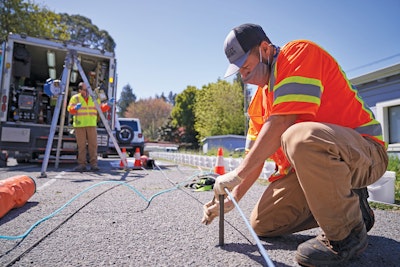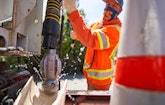
Ross Valley (California) Sanitary District General Manager Steve Moore (second from left) and operations managers Noel Sandoval, Manuel Vigil and Rafael Zarco (from left) have helped further the district’s competency-based training program. (Photography by Collin Chappelle)
Interested in Education/Training?
Get Education/Training articles, news and videos right in your inbox! Sign up now.
Education/Training + Get AlertsDuring the past decade, the Ross Valley Sanitary District has experienced a seismic shift in operations, including $100 million in infrastructure improvements, investments in asset-management technologies, and in-house maintenance and repair of sewer lines and pump stations.
The utility — based in San Rafael, California, about 20 miles north of San Francisco — was established in 1899 and is one of the state’s oldest wastewater utilities. Beyond infrastructure and technology investments, it has also embraced a training method that captures institutional knowledge about processes and procedures. Known as competency-based training, it has improved workers’ retention of that knowledge and, in turn, increased their efficiency, says Steve Moore, the utility’s general manager.
Developed by the military, CBT centers on comprehensive, step-by-step training protocols that emphasize consistency through numerous repetitions, which leads to competency.
“Everyone knows training is important, but we didn’t have an organized training program — just a manufacturer’s manual or a consultant’s emergency procedures report,” Moore explains. “But those references don’t assess an employee’s competency on using equipment such as hydro-jetters, vacuum trucks and pipeline inspection cameras.”
That’s where CBT comes in. After the utility develops detailed standard operating procedures and trains employees by using those procedures, a trained assessor then grades them on how well they understand or don’t understand each task embedded in the SOP.
The rest of the training then focuses on what employees don’t know, which develops more qualified equipment operators.
“After assessment, we train to what they don’t know, which we call training to the delta,” Moore says. “And by developing SOPs, we capture institutional knowledge that can be transferred to new employees. That knowledge doesn’t disappear if, say, an employee retires.
“Competency-based training enables us to tacitly embed knowledge for new operators more efficiently and methodically than before, using consistent, user-friendly standard operating procedures for the full variety of tasks, developed by internal subject-matter experts.”
The utility started using CBT in 2017 by hiring Competency Training Systems International. A chief technology officer from CTSI helped the utility develop the procedure-based SOPs.
Practice makes perfect
Moore cites cured-in-place point repairs as an example of the benefits CBT brings. Without competency-based SOPs, it might take some employees up to two years before they feel confident making the point repairs.
“But with competency-based training, they’re up and running in about a month,” he says.
The secret sauce is the step-by-step SOPs, which make liberal use of pictures with text boxes and arrows.
“People respond more favorably and efficiently to pictures than manuals and text, so the step-by-step training with visuals, repetitions and constant feedback better engages the workers,” Moore explains. “Before, everyone was trained differently by word-of-mouth for the same job.
“Today we have a much more consistent work environment. We’ve also reduced the amount of time it takes to complete tasks, which allows us to get more done in less time.”
Hundreds of training modules have been developed in all, ranging from operating equipment to maintaining lift stations to flushing sewer mains using specialized vehicles.
“We’ve covered the critical tasks, but SOP development and training is ongoing as new equipment is brought online. It’s really a never-ending process,” Moore says.
In-house expertise
For an example of how CBT reduces expenses, consider the cured-in-place point repairs. Some utilities install one point repair liner a day, while RVSD crews perform an average of three per day and have installed as many as seven in a day, says Manuel Vigil, repair supervisor.
Furthermore, doing the work in-house saves money. Having an outside contractor do a point repair would cost about $2,500. With an average of 400 such repairs annually, that comes to $1 million, he says.
“We can do the same number of repairs for about $400,000 in labor, equipment and materials, so we save the district about $600,000 a year. So over the years, we’ve saved millions of dollars by doing point repairs in-house.”
To handle the work, the utility invested in a 2014 Isuzu NQR cube van that carries a wet-out table. Vigil buys generic components such as the epoxy, fiberglass liners and inflatable bladders to create a customized point-repair system.
“That way, the things we need for point repairs cost $50 to $60 versus $400 to $500,” he says.
System challenges
A spike in sewer overflows, followed by a cease-and-desist order from the state’s Regional Water Quality Control Board issued in 2013, also spurred changes at RVSD.
In addition to investing approximately $100 million in infrastructure improvements and upgrades to reduce overflows, the utility adopted new technologies to assess and manage its 194 miles of gravity sewer, 8 miles of force mains, 5,200 manholes and rod-holes, and 19 pump and lift stations.
The collections system serves about 47,000 customers and transports approximately 4 mgd to a treatment plant operated by the Central Marin Sanitation Agency. The agency operates under a joint agreement among the RVSD, the San Rafael Sanitation District and Sanitary District No. 2 of Marin County.
Another critical step in the utility’s evolution involved creating a risk-assessment model for its infrastructure, then developing a structured management plan to address long-standing deficiencies.
To do this, the utility invested in ArcGIS software from Esri, and InfoAsset, a maintenance-management system developed by Innovyze. The two work in concert to help the agency develop an enterprise asset management and maintenance system.
“Every asset now is on a maintenance, repair or capital improvement schedule,” Moore notes. “The asset management program provides a comprehensive inventory and ongoing condition assessment, as well as a platform to prioritize repairs and rehabilitation and adaptively manage preventive maintenance schedules.
“In essence, these technologies allow us to make data-driven decisions about how to extend the life cycle of our assets in a proactive manner instead of a reactive manner. Regulators and ratepayers now see an agency that has a transparent, risk-based approach to in-house repair and maintenance, as well as a capital improvement program. We are no longer managing crisis by crisis, or by using imprecise metrics like ‘miles cleaned.’”
Fewer overflows
Sewer overflows, for example, dropped to 13 in fiscal year 2019-20 compared to 38 in the 2016-17 fiscal year. In addition, gallons of wastewater spilled decreased significantly during the same time period, from 135,000 gallons down to just 3,682 gallons.
For an even starker comparison, overflows spilled almost 3 million gallons in fiscal year 2010-11, he notes.
Another benefit: The technology helped the utility become more surgical in terms of preventive maintenance.
“Our motto became ‘clean only what needs to be cleaned,’” says Rafael Zarco, line maintenance supervisor.
The upshot is that the agency no longer operates with a mentality that every pipe needs to be cleaned on a regular basis. Instead, the technology allows officials to prioritize which pipes need cleaning based on how much debris is removed as well as the condition assessment data.
“We now clean a couple thousand less feet of pipe per year while at the same time we’re still experiencing fewer overflows,” Zarco says. “Furthermore, cleaning a clean pipe produces unnecessary wear and tear on the system.”
Equipment investments
To do more work in-house, the utility has invested significantly in equipment. The RVSD’s equipment roster includes a Vac-Con combination truck, two Vactor Ramjet truck-mounted jetters, built out on International chassis with 1,500-gallon water tanks and Vactor water pumps.
The utility also relies on two low-volume, high-pressure jetting trucks outfitted by Harben on Ford F-550 chassis with 600-gallon water tanks and Harben pumps.
Crews tackle sewer line inspections with two camera trucks, both Mercedes-Benz Sprinters. One carries a RapidView IBAK Panoramo 4K camera system and the other transports a Pathfinder system from Aries Industries. Both systems utilize WinCan data-collection software.
The RVSD also owns push cameras made by Envirosight, CUES and IBAK.
Scalable approach
The RVSD’s experience with CBT offers some clear takeaways for other utilities.
For starters, Moore would like to dispel any notions that CBT is feasible only at larger utilities. It’s very doable for small agencies, too, with the right program and right people in place. (The RVSD has just 35 employees.)
Furthermore, Moore encourages other utilities to think outside the box and be willing to take chances, then learn from any mistakes. As an example, he cites failed point repairs.
“You just have to commit to reviewing repairs as part of CCTV work, and where you identify defects, do a failure analysis, then modify the SOP if necessary to reflect the findings of that analysis. Then it’s automatically incorporated into training as the SOP is implemented.”
Moreover, utilities should take advantage of efficiencies offered by new technology, such as the ArcGIS and InfoAsset systems, Moore says.
“Technology is key. Everybody has a cellphone and portable laptops are more affordable and durable. Work orders and sewer system maps, with sewer lateral or asset information history at our fingertips, are creating efficiency and effectiveness in the field.
“It’s also increasing the confidence of our workforce to get the job done to protect public health and the environment.”
Accomplishing goals
But no matter how the utility evolves, CBT training will remain a cornerstone of its operations.
“Our main goal with CBT was to create a consistent, safe and effective work environment,” he says. “And our long-term goal is to keep the sewer rates low and ensure public health and safety. And I think we’re accomplishing all those goals.
“We’ve come a long way. We’re totally committed to the path of continuous improvement and adaptive management.”








